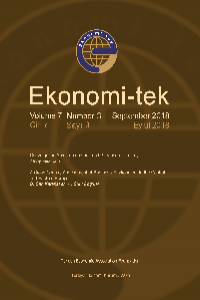Calculation of the Human Development Index For Northern Cyprus Using Economic Measurements From The Post-Conflict Period
Development has always been treated as an economic phenomenon and linked to economic growth. Amartya Sen’s “capabilities” approach (Sen, 1985) introduced the concept of “human development” as progress towards greater societal well-being. The Human Development Index, the HDI, is a summary measure of average achievement in key dimensions of life: a long and healthy lifespan, being knowledgeable, and having a decent standard of living. The HDI relies on various proxies to demonstrate key capabilities: i.e., access to health, education, and goods. The HDI is the geometric mean of these three-dimensional indices. The HDI has been calculated by the United Nations Development Program (UNDP) since 1990 and serves as a measure of human well-being; it ranks countries on a scale between zero and one. Northern Cyprus (herein referred to as the Turkish Republic of Northern Cyprus, or the TRNC) has been ignored in such calculations, although the HDI has been applied to similar territories. Thus, the purpose of this paper is to calculate the HDI for the TRNC using observed series during its post-conflict era. At the same time, we discuss the Granger Causality of HDI in Northern Cyprus and Turkey. The finding indicates that the HDI of the TRNC has the ability to predict the HDI of Turkey, while its reverse is not true. The paper also examines the relationships between HDI and GNI according to separate Fixed-Effect Panel Models and Seemingly Unrelated Regression (SUR) Equations of HDI and GNI.
Anahtar Kelimeler:
Human Development Index, Granger Causality, Fixed-Effect Panel Data Models, SUR Estimates
Calculation of the Human Development Index For Northern Cyprus Using Economic Measurements From The Post-Conflict Period
Development has always been treated as an economic phenomenon and linked to economic growth. Amartya Sen’s “capabilities” approach (Sen, 1985) introduced the concept of “human development” as progress towards greater societal well-being. The Human Development Index, the HDI, is a summary measure of average achievement in key dimensions of life: a long and healthy lifespan, being knowledgeable, and having a decent standard of living. The HDI relies on various proxies to demonstrate key capabilities: i.e., access to health, education, and goods. The HDI is the geometric mean of these three-dimensional indices. The HDI has been calculated by the United Nations Development Program (UNDP) since 1990 and serves as a measure of human well-being; it ranks countries on a scale between zero and one. Northern Cyprus (herein referred to as the Turkish Republic of Northern Cyprus, or the TRNC) has been ignored in such calculations, although the HDI has been applied to similar territories. Thus, the purpose of this paper is to calculate the HDI for the TRNC using observed series during its post-conflict era. At the same time, we discuss the Granger Causality of HDI in Northern Cyprus and Turkey. The finding indicates that the HDI of the TRNC has the ability to predict the HDI of Turkey, while its reverse is not true. The paper also examines the relationships between HDI and GNI according to separate Fixed-Effect Panel Models and Seemingly Unrelated Regression (SUR) Equations of HDI and GNI.
Keywords:
Human Development Index, Granger Causality, Fixed-Effect Panel Data Models, SUR Estimates,
___
- Bilbao-Ubillos, J., (2012), “Another Approach to Measuring Human Development: The Composite Dynamic Human Development Index,” Social Indicators Research, 111(2), pp. 473-484.
- Booysen, F., (2002), “An Overview and Evaluation of Composite Indices of Development,” Social Indicators Research, 59 (2), pp. 115-151
- Crespo, R. F., (2012), “Socio-Economic Machines and Practical Models of Development: The Role of the HDI,” In: R. F. Crespo, Theoretical and Practical Reason in Economics, Springer, New York pp. 81-104.
- Drechsler, J., (2011), “Background on Multiple Imputation,” In: Synthetic Datasets for Statistical Disclosure Control. Lecture Notes in Statistics, Vol. 201. Springer, New York, NY.
- Fukuda-Parr, S., Lawson-Remer, T., and S. Randolph, (2010), “An Index of Economic and Social Rights Fulfilment: Concept and Methodology,” Journal of Human Rights, 8(3), pp. 195-221.
- Ganegodage, K., Rambaldi, A., Rao, D., and K. Tang, (2015), “A New Multidimensional Measure of Development: The Role of Technology and Institutions,” Social Indicators Research, 131(1), pp. 65-92.
- Huggins, M., (2005), Genero, Politicas Publicas y Promocion de la Calidad de Vida. Instituto Latinoamericano de Investigaciones Sociales, Caracas.
- Lind, A., (1992), “Power, Gender, and Development: Women’s Organizations and the Politics of Needs in Ecuador,” In: A. Escobar and S. Alvarez (eds.), The Making of Social Movements in Latin America: Identity, Strategy, and Democracy. Westview Press, pp. 132-149.
- Little, R. J. A., (1993), “Statistical Analysis of Masked Data,” Journal of Official Statistics, 9, pp. 407-426.
- Mehmet, Özay, (2010), Sustainability of Microstates, The Case of Northern Cyprus. University of Utah.
- Myint, H., (1958), “The ‘Classical Theory’ of International Trade and Underdeveloped Countries,” The Economic Journal, 68 (2), pp. 317-337.
- Presidency of the Turkish Republic of Northern Cyprus, (2017). https://kktcb.org.
- Sagar, A. D., and A. Najam, (1998), “The Human Development Index: A Critical Review,” Ecological Economics, 25, pp. 249-264.
- Sen, Amartya, (1985), Commodities and Capabilities, North Holland, Amsterdam.
- Thompson, S., St. Karayanni, S., and M. Vassiliadou, (2004), Cyprus After History, Interventions, 6 (2), pp. 282-299, DOI: 10.1080/1369801042000238373.
- UNDP, (2010), Human Development Report 2010, Pathways to Human Development. 20th Anniversary Edition. Oxford University Press, New York.
- UNDP, (2016), Human Development for Everyone. The United Nations Development Programme. http://hdr.undp.org/sites/ default/files/2016_human_development_report.pdf.
- UNDP, (2016), Human Development Report 2016, Technical Notes.http://hdr.undp.org/sites/default/files/hdr2016_technical_notes.pdf.
- ISSN: 2146-6173
- Yayın Aralığı: Yılda 3 Sayı
- Başlangıç: 2012
- Yayıncı: Türkiye Ekonomi Kurumu Vakfı
